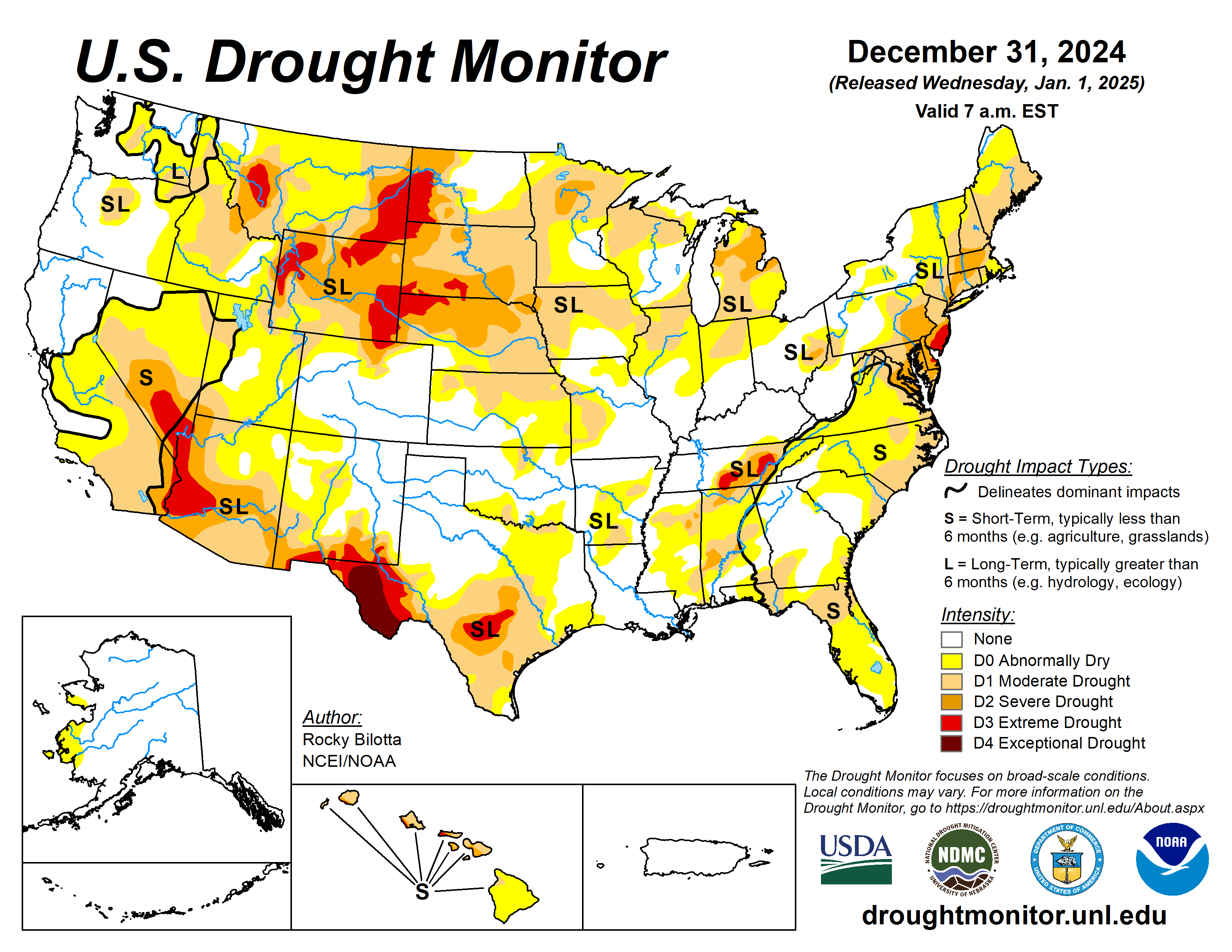Precipitation fell across much of the United States this past week, with heavier amounts (more than 1 inch) falling across large portions of the Northwest and from southcentral U.S. to the Ohio Valley.
Coastal areas of the Pacific Northwest, from Washington to northern California, reported weekly rainfall totals between 2 to 15 inches, while precipitation totals of 2 to 10 inches were reported in areas from eastern Texas to Alabama, as well as parts of the Ohio Valley and the Southeast.
Above-normal precipitation supported drought improvements across large portions of the South and Midwest, and in parts of the Pacific Northwest, Midwest and Southeast. Conversely, weekly precipitation totals were below normal in areas of the southwestern U.S., Mid-Atlantic and Northeast. Drought and abnormal dryness were expanded or intensified in portions of the Southwest and in small pockets of the High Plains.
Temperatures were above normal across much of the U.S. Areas along the northern tier, from northern portions of the West, to the Midwest observed temperatures 10 to 25 degrees Fahrenheit above normal. Below-normal temperatures were reported across northern portions of the Northeast, from northern New Jersey to Maine, where departures were up to 5 degrees below normal. Below-normal temperatures were also observed in small pockets of the Southeast.
The U.S. Drought Monitor is jointly produced by the National Drought Mitigation Center at the University of Nebraska-Lincoln, the U.S. Department of Agriculture and the National Oceanic Atmospheric Administration. (Map courtesy of NDMC.)
South
Heavy rainfall was observed across much of the South, with precipitation totals ranging between 1 to 8 inches above normal. Above-normal rainfall, with amounts up to 600% above normal, along with improvements shown in short-term SPI/SPEI, streamflow and soil moisture data, supported widespread improvements to drought made from eastern Texas to Mississippi.
Severe drought was removed along the Oklahoma-Texas and Louisiana-Arkansas borders, as well as from southern Mississippi, and improved in central Texas. Moderate drought was improved over large portions of Arkansas, eastern Texas, and in parts of Oklahoma. Conversely, western portions of Oklahoma and Texas observed below-normal precipitation.
Moderate drought and abnormal dryness were expanded in small parts of western Texas. Temperatures were above normal across the entire region this week, with departures ranging between 1 to 15 degrees above normal.
Midwest
Above-normal temperatures, with departures ranging between 5 to 20 degrees F above normal, were observed across the entire Midwest region this week, with the largest temperature departures being observed in northern Minnesota.
Precipitation was reported across most of the region, with much of the region observing weekly rainfall totals between 200% to 600% above normal. Severe drought was removed in parts of Minnesota, Iowa and Missouri. Below-normal precipitation was observed over western portions of Minnesota and Iowa.
High Plains
Warm temperature dominated the High Plains, with departures ranging up to 20 degrees above normal, especially along the northern portions of the region. Precipitation fell across much of the region, but amounts were not large enough to justify large improvement across much of the High Plains.
Extreme drought was expanded in northern Nebraska, while moderate drought was expanded in southeast Kansas. Abnormal dryness was expanded in southwest Colorado, where weekly rainfall totals are 5% to 20% or normal for the week. Small areas of the region did observe heavy rainfall, where rainfall totals were more than an inch above normal.
This above-normal precipitation allowed for improvements to be made in South Dakota and along the Wyoming-Colorado border. Moderate to extreme drought were improved in northern Colorado and southern Wyoming, while severe drought was improved in western South Dakota. Abnormal dryness was also improved in areas along the Wyoming-Colorado border this week.
West
Montana observed temperatures ranging between 6 to 15 degrees above normal. Moderate to severe drought were improved in western Montana.
Abnormal dryness was expanded in parts of Colorado and New Mexico.
Looking ahead
During the next five days (Dec. 31 to Jan. 4) a low- pressure system tracking from the Ohio Valley into the Northeast will spread precipitation across those regions Tuesday to Wednesday.
Precipitation should fall as rain for most of the Ohio Valley to the coastal areas/lower elevations of the Northeast. Snow is likely in the higher elevation areas of the Interior Northeast like the Adirondacks and the Green and White Mountains.
The Pacific Northwest will see a relative break in precipitation on Tuesday after a steady train of atmospheric rivers into the region. Rounds of precipitation are likely to continue through late week and at times farther east into the northern Rockies. Colder than normal temperatures will also impact the north-central U.S., and lows could reach 10 to 15 degrees below zero over northern North Dakota and Minnesota by Friday and/or Saturday.
Meanwhile, the amplifying upper ridge over the West will promote warming, with temperatures generally 5 to 15 degrees above average increasing in coverage by the second half of the week. Locally higher anomalies are likely in the Southwest and highs could reach well into the 70s. Highs of 5 to 15 degrees above normal may reach into the southern High Plains by next Saturday.
The Climate Prediction Center’s 6- to 10-day outlook (valid Jan. 5 to 9) favors above-normal precipitation across much of the U.S., with below-normal precipitation favored in portions of the Southwest. Below-normal temperatures are likely from the northern Rockies to the East Coast.
Rocky Bilotta is with the National Oceanic Atmospheric Administration and the National Centers for Environmental Information.




